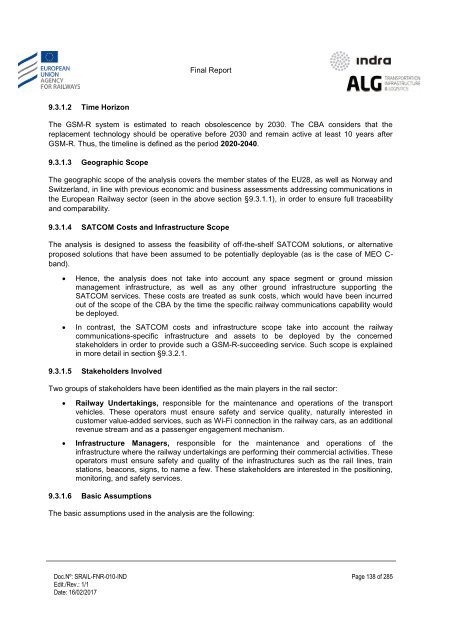Study on feasibility of SATCOM for railway communication
SRAIL-FNR-010-IND%20-%20FinalReport_v1.1_20170216
SRAIL-FNR-010-IND%20-%20FinalReport_v1.1_20170216
Create successful ePaper yourself
Turn your PDF publications into a flip-book with our unique Google optimized e-Paper software.
Final Report<br />
9.3.1.2 Time Horiz<strong>on</strong><br />
The GSM-R system is estimated to reach obsolescence by 2030. The CBA c<strong>on</strong>siders that the<br />
replacement technology should be operative be<strong>for</strong>e 2030 and remain active at least 10 years after<br />
GSM-R. Thus, the timeline is defined as the period 2020-2040.<br />
9.3.1.3 Geographic Scope<br />
The geographic scope <strong>of</strong> the analysis covers the member states <strong>of</strong> the EU28, as well as Norway and<br />
Switzerland, in line with previous ec<strong>on</strong>omic and business assessments addressing communicati<strong>on</strong>s in<br />
the European Railway sector (seen in the above secti<strong>on</strong> §9.3.1.1), in order to ensure full traceability<br />
and comparability.<br />
9.3.1.4 <strong>SATCOM</strong> Costs and Infrastructure Scope<br />
The analysis is designed to assess the <strong>feasibility</strong> <strong>of</strong> <strong>of</strong>f-the-shelf <strong>SATCOM</strong> soluti<strong>on</strong>s, or alternative<br />
proposed soluti<strong>on</strong>s that have been assumed to be potentially deployable (as is the case <strong>of</strong> MEO C-<br />
band).<br />
<br />
<br />
Hence, the analysis does not take into account any space segment or ground missi<strong>on</strong><br />
management infrastructure, as well as any other ground infrastructure supporting the<br />
<strong>SATCOM</strong> services. These costs are treated as sunk costs, which would have been incurred<br />
out <strong>of</strong> the scope <strong>of</strong> the CBA by the time the specific <strong>railway</strong> communicati<strong>on</strong>s capability would<br />
be deployed.<br />
In c<strong>on</strong>trast, the <strong>SATCOM</strong> costs and infrastructure scope take into account the <strong>railway</strong><br />
communicati<strong>on</strong>s-specific infrastructure and assets to be deployed by the c<strong>on</strong>cerned<br />
stakeholders in order to provide such a GSM-R-succeeding service. Such scope is explained<br />
in more detail in secti<strong>on</strong> §9.3.2.1.<br />
9.3.1.5 Stakeholders Involved<br />
Two groups <strong>of</strong> stakeholders have been identified as the main players in the rail sector:<br />
<br />
<br />
Railway Undertakings, resp<strong>on</strong>sible <strong>for</strong> the maintenance and operati<strong>on</strong>s <strong>of</strong> the transport<br />
vehicles. These operators must ensure safety and service quality, naturally interested in<br />
customer value-added services, such as Wi-Fi c<strong>on</strong>necti<strong>on</strong> in the <strong>railway</strong> cars, as an additi<strong>on</strong>al<br />
revenue stream and as a passenger engagement mechanism.<br />
Infrastructure Managers, resp<strong>on</strong>sible <strong>for</strong> the maintenance and operati<strong>on</strong>s <strong>of</strong> the<br />
infrastructure where the <strong>railway</strong> undertakings are per<strong>for</strong>ming their commercial activities. These<br />
operators must ensure safety and quality <strong>of</strong> the infrastructures such as the rail lines, train<br />
stati<strong>on</strong>s, beac<strong>on</strong>s, signs, to name a few. These stakeholders are interested in the positi<strong>on</strong>ing,<br />
m<strong>on</strong>itoring, and safety services.<br />
9.3.1.6 Basic Assumpti<strong>on</strong>s<br />
The basic assumpti<strong>on</strong>s used in the analysis are the following:<br />
Doc.Nº: SRAIL-FNR-010-IND<br />
Edit./Rev.: 1/1<br />
Date: 16/02/2017<br />
Page 138 <strong>of</strong> 285


